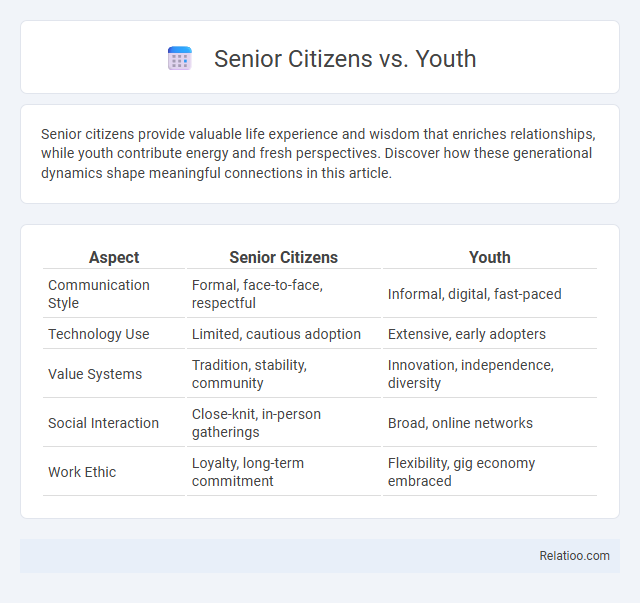Senior citizens provide valuable life experience and wisdom that enriches relationships, while youth contribute energy and fresh perspectives. Discover how these generational dynamics shape meaningful connections in this article.
Table of Comparison
| Aspect | Senior Citizens | Youth |
|---|---|---|
| Communication Style | Formal, face-to-face, respectful | Informal, digital, fast-paced |
| Technology Use | Limited, cautious adoption | Extensive, early adopters |
| Value Systems | Tradition, stability, community | Innovation, independence, diversity |
| Social Interaction | Close-knit, in-person gatherings | Broad, online networks |
| Work Ethic | Loyalty, long-term commitment | Flexibility, gig economy embraced |
Introduction: Bridging the Generation Gap
Bridging the generation gap involves fostering mutual understanding and respect between senior citizens and youth, who often experience distinct cultural, technological, and social perspectives. Initiatives promoting intergenerational dialogue and shared activities help reduce misconceptions and build meaningful connections across age groups. Emphasizing common values and collaborative goals supports a more inclusive society that values the contributions of all ages.
Defining Senior Citizens and Youth
Senior citizens are typically defined as individuals aged 65 and older, a demographic recognized for retirement status, increased healthcare needs, and accumulated life experience. Youth generally refers to individuals between the ages of 15 and 24, characterized by rapid physical, mental, and emotional development, as well as educational and career pursuits. The age gap between senior citizens and youth highlights differences in societal roles, economic contributions, and generational perspectives, influencing policy-making and intergenerational dynamics.
Perspectives on Technology Adoption
Senior citizens often face challenges in technology adoption due to limited exposure and apprehension toward rapidly evolving digital tools, contrasting sharply with youth who generally embrace new technologies with ease and adaptability. The age gap influences attitudes, where younger generations prioritize efficiency and connectivity, while seniors value simplicity and security in technology use. Understanding these perspectives is crucial for designing inclusive digital solutions that bridge generational divides and promote technological accessibility for all age groups.
Attitudes Toward Work and Career
Senior citizens often prioritize job security and meaningful contributions based on decades of experience, while youth focus on career growth, innovation, and work-life balance, reflecting generational shifts in workplace values. The age gap influences attitudes toward work flexibility and technology adoption, with younger workers embracing digital tools more readily. Understanding these differences can help you foster intergenerational collaboration that leverages diverse perspectives for organizational success.
Health and Wellness Concerns
Senior citizens face increased challenges related to chronic illnesses and mobility issues, while youth often prioritize mental health and preventive wellness practices. The age gap influences healthcare needs, with older adults requiring more specialized medical attention and younger populations focusing on fitness and stress management. Addressing these distinct health and wellness concerns demands tailored approaches to promote overall well-being across all age groups.
Social Interaction Styles
Senior citizens often prefer face-to-face social interactions characterized by deep, meaningful conversations, while youth tend to engage more through digital platforms emphasizing frequent, brief exchanges. The age gap influences communication styles, with seniors valuing patience and reflection, contrasting with the youth's preference for rapid, multimedia communication. Understanding these differing social interaction styles is critical for fostering intergenerational connections and reducing social isolation across age groups.
Political and Social Values
Senior citizens often prioritize stability, tradition, and policies supporting healthcare and pensions, reflecting their life experiences and social values rooted in preservation. Youth tend to emphasize progressive change, social justice, and innovation, advocating for issues like climate action and equality, which highlight their forward-looking political stance. The age gap creates contrasting political priorities, with generational divides impacting voter behavior, policy preferences, and social cohesion across societies.
Financial Priorities and Challenges
Senior citizens prioritize healthcare expenses and retirement savings, often focusing on fixed incomes and managing medical costs. Youth typically emphasize education loans, career investments, and building credit, facing challenges like student debt and entry-level salaries. The age gap reveals differing financial goals and challenges, with seniors seeking stability while youth concentrate on growth and long-term wealth accumulation.
Lifelong Learning and Education
Lifelong learning bridges the age gap between senior citizens and youth by promoting continuous education and skill development across generations. Senior citizens benefit from lifelong learning programs that enhance cognitive health and social engagement, while youth gain from intergenerational knowledge exchange that fosters empathy and diverse perspectives. Educational initiatives that integrate both age groups cultivate inclusive learning environments, reducing age-related disparities and supporting personal growth at every stage of life.
Building Mutual Understanding and Respect
Bridging the age gap between senior citizens and youth requires fostering open communication and shared experiences that highlight common values and goals. Promoting intergenerational activities and mentorship programs encourages empathy, respect, and the exchange of wisdom, reducing stereotypes and misunderstandings. Building mutual understanding enhances social cohesion and enriches communities by valuing diverse perspectives from different age groups.

Infographic: Senior citizens vs Youth
 relatioo.com
relatioo.com